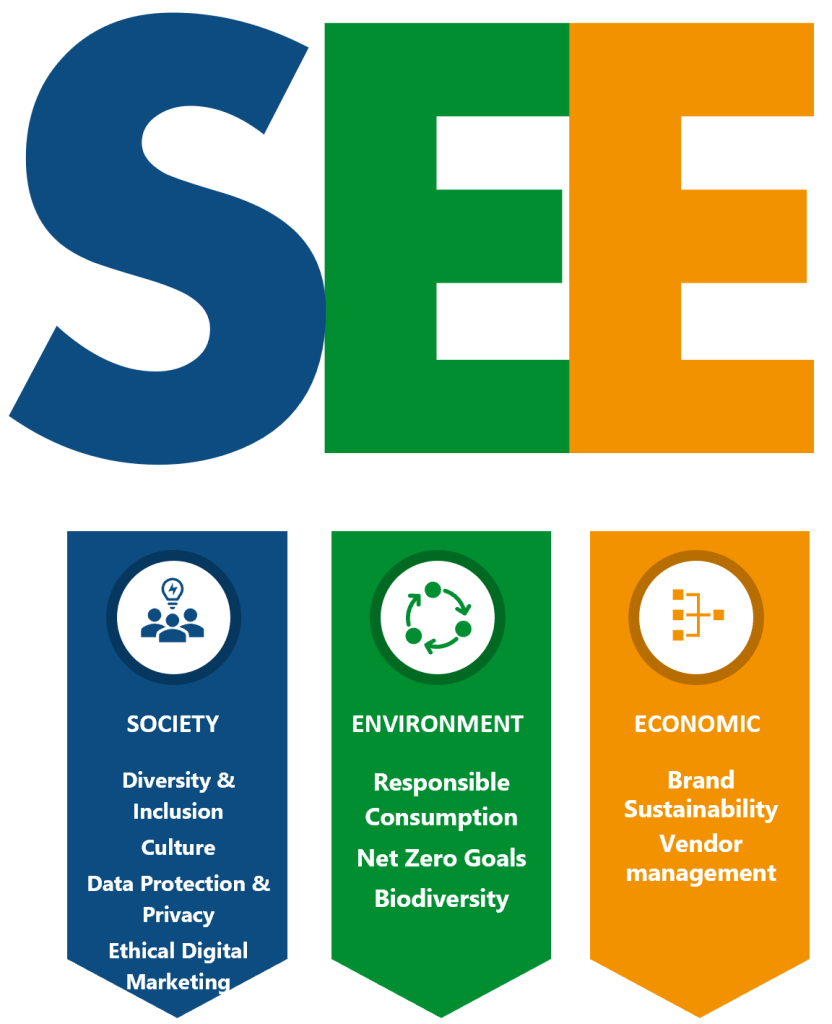Flock were delighted to recently release our Marketing Sustainability whitepaper, “The Sustainable Marketer”. The paper includes a framework to help marketing organizations build a Marketing Sustainability Strategy, with useful resources, best practices as well as case studies from our partners at WARC.
To access the full paper and all associated resources included, download using the link below.
The framework is based on 3 simple principles: SEE, ACT, MEASURE. S.E.E stands for Society, Environment, Economy, and highlights the key topics that marketing can directly affect within the 3 areas of sustainability. This blog focuses on the first “E” of SEE – Environment. You can find details on Society and Economy in our downloadable whitepaper (see link above).

ENVIRONMENTAL IMPACT
A sustainable impact on the environment continues to attract great focus and attention in a bid to overcome the growing challenges we face. Marketing communications are invaluable when creating global awareness. Environmental Impact has been broken down into the following key areas we believe marketing can impact most.
- Net Zero Goals
- Responsible Consumption
- Biodiversity
1. Net Zero Goals
To achieve Net Zero goals within our industry, a number of initiatives have been launched and we would encourage marketers and agencies to join Planet Pledge launched by the WFA and Ad Green, which is helping to unite the advertising industry to eliminate the environmental impact of advertising production.
For many companies, ensuring sustainable practice across their supply chains can be the biggest challenge which is why collaboration is key. One example of this is Walmart’s Sustainability Hub which is a platform for their suppliers to access resources and best practices, to join initiatives and to learn about opportunities to collaborate with Walmart.
Key questions to help you A.C.T.
- Are you communicating your company’s efforts in protecting the environment and meeting net-zero goals to your employees, suppliers and consumers? Are you also being open and honest in sharing the work that your company still needs to do?
- Do you have a sustainability scorecard, carbon calculator or another tool that enables you to measure, track and improve your organization’s sustainability performance as well as your suppliers?
- Do you have a sustainable travel policy in place, and with your partners, that outlines what is considered “essential” air travel?
2. Responsible Consumption
Consumers are continuing to seek out brands that provide products and services that are responsibly sourced and enable them to act more sustainably in their own lives. As per the Futerra study, 88% of respondents wanted brands to help them be more environmentally friendly and ethical in their daily life, however, only 28% said that brands made it easier for them to do so.
To address this opportunity, a number of brands are launching campaigns and initiatives to enable responsible consumption. H&M which aims to have all of their products made from recycled or other sustainably sourced materials by 2030, encourages consumers to “wash less, repair, recycle and repeat”
Key questions to help you A.C.T.
- Do you make it easy for your consumers to act sustainably through the use of your product or service?
- If your company has a canteen, does leftover food get donated to homeless shelters or underprivileged communities?
- Do you collaborate with suppliers and other brands to drive responsible consumption practices together?
3. Biodiversity
A statement from the UN Report: IPBES Global Assessment Report on Biodiversity and Ecosystem Services highlights why biodiversity matters: “Biodiversity and nature’s contributions to people are our common heritage and humanity’s most important life-supporting ‘safety net’. But our safety net is stretched almost to breaking point.”
We are simply killing our world. Over 1,000,000 species of animals are at risk of extinction. More than 40% of amphibian species, almost 33% of reef-forming corals and more than a third of all marine mammals are threatened. At least 680 vertebrate species have been driven to extinction since the 16th Century and more than 95 of all domesticated breeds of mammals used for food and agriculture have become extinct by 2016, with at least 1,000 more breeds still threatened.
Key questions to help you A.C.T.
- What is the impact your brand has on Biodiversity?
- Do you make it easy for your consumers to understand the impact of your business, and your supply chain, including all ingredients?
- What partnership alliances can you strike or support that will positively improve Biodiversity?
Access “The Sustainable Marketer” for more information, key questions, and resources on how marketers can improve their environmental impact here.
Learn more about what Flock are doing to become more sustainable click here.
Take the Flock Marketing Sustainability Benchmark Survey click here.
Or, to chat to us about your own thoughts on Marketing Sustainability, feel free to contact us using the form below. We’d love to hear from you!


